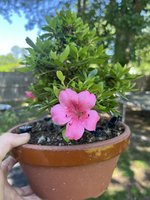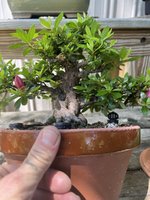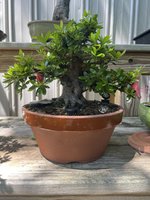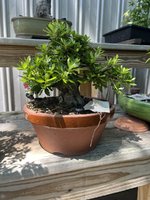Sorry for the delay, we both had to get ready for a study group….
Guess what I was trying to convey was… at least in my mind , this azalea trunk reaches out to me asking for a design if not better, bigger…or perhaps more formal design than the basic johng pattern. (Not implying his pattern isn’t great.

)
Here’s an example of a design of one of the trees was thinking about. It’s working towards a long arm azalea, as suggested before, long arm on left. Hino Maru
View attachment 540038
Glad
@Chuah dropped in, as he has a really good design for his chinzan and another possible approach for the tree… His clip and grow skills are awesome btw.
Not sure ever mentioned cutting back hard, but
@Chuah demonstrated an awesome example of this process…..
This is true. Given one does not apply properly or care for their tree properly, this can indeed happen.
There are well over 200 satsuki and other azalea we work on. 90+ cultivars. None seem to be affected by dead roots or fertilizer pockets….
Both quantity and quality of the nutrients (and delivery time) are most important then organic or inorganic.
.
Personally don’t care what fertilizer anyone else uses, organic or chemically derived, as long as the azalea gets an acidic based fertilizer with needed micronutrients at low doses. Do it your own way. (But please keep an open mind to the ideas of other experienced practitioners .)
But there is a downside to each
We see lots of azaleas not doing well due to gunked up media. Biogild and Holly Tone types tend to be the worst. Constant application of fish fertilizer will also gunk up the media. Rather do soji only when it’s absolutely needed. (Also don’t like lugging watering cans around at frequent intervals.)
We recycle all our media, APL and Kanuma/Pumice. If you do so, you’ll know right off which batch came from organic fertilizer users and/or tree s that have not been repotted for a long time.
Chemical fertilizer can damage the roots of azaleas if one doesn’t recognize azaleas need less fertilizer then other trees. A couple years ago we actually counted the number of pellets wanted of Osmocote Plus for azaleas in various pot sizes to avoid this issue. This was equated to a measuring spoon to speed up application. 1/16” of TSP is our smallest pot ferts
However we only apply Osmocote Plus twice a year. After flowering and early September when the temperates recede a liquid fertilizerr supplement is used. For example weak dose of miracid, humic+kelp.
Tried them.. no time, lots of plastic and chasing tea bagscaround. . However the area of media under the applicator was always gunky afterwards .
Never understood what a maintenance dose was? Isn’t it a term used for fertilizer applications for a refined tree…?
Watering is an individual thing, varying by location, media used, size and style of pot, time of year and tree type. So can’t comment on this. But sounds like you have a handle on watering.
Fertilization is an intentional process. Each tree has its own profile. If you think that’s appropriate based upon experience with azaleas, that’s ok. The impression was the tree wasn’t getting enough micronutrients.
Only need to do this process if the soil is properly absorbing water. Soji is only done to enhance percolation. Out here we don’t do it, as percolation is good for three years if Yamagoke moss is used.
Moss replacement is only done for percolation or aesthetic reasons. If one does replace or remove Yamagoke, it’s possible to wash and dry the removed moss, rehydrate and use again…. And save some bucks side a new tree

Thanks
Cheers
DSD sends
)





